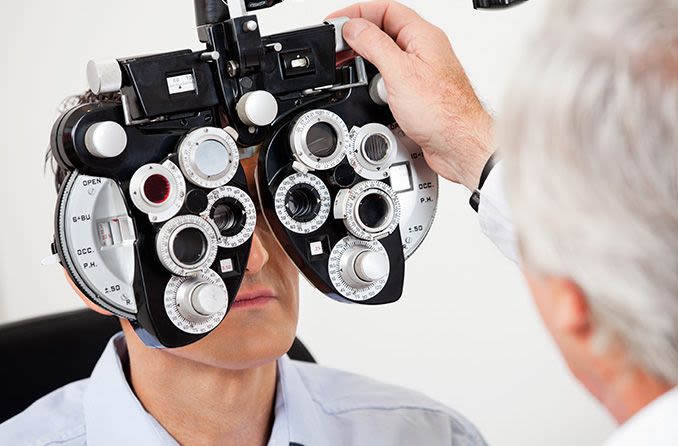What happens during a refractive eye exam?

A refractive eye exam, also referred to as a vision test or simply a refraction, is the test used to determine your vision prescription. It’s commonly performed as part of a comprehensive eye exam.
If you wear glasses or contacts or if you’ve ever had your vision tested, you’ve had a refractive eye exam. It’s the one that involves looking at a bunch of letters through a device while the eye doctor flips lenses back and forth, asking you which options look better.
“One … or two?”
“Two … or three?”
Sound familiar?
During this process, a refraction test will determine which type of refractive error is present, if any. The four standard refractive errors are nearsightedness, farsightedness, age-related farsightedness and astigmatism.
TIME TO UPDATE YOUR PRESCRIPTION? Find an eye doctor near you and make an appointment today.
What is included in a refractive eye exam?
A refraction exam is painless and relatively quick.
First, your eye doctor will lower a large tool covered in dials, switches and lenses. This is called a phoropter and is probably the tool you most associate with an eye exam.
The optometrist will have you look through the phoropter and at a vision chart either 20 feet away or reflected on a mirror to appear 20 feet away. You might recognize this chart covered in bold, black letters that are larger at the top and get progressively smaller as they reach the bottom.
Your doctor will then adjust the power of the lenses, shifting or flipping them back and forth until the letters on the chart look as good to you as they would to someone with 20/20 vision.
And that’s it — your optometrist can now accurately determine your vision prescription and refractive error.
SEE RELATED: What is your eye doctor doing when they ask, “Which is better?"
What can a refractive exam be used to diagnose?
The human eye works with a delicate balance of different components, so the smallest shift in the way any component processes images can result in blurry vision. When light incorrectly refracts inside the eye, the result is refractive error.
This test is primarily used to diagnose one or more of the four main refractive errors:
Myopia, known as nearsightedness. If you can see things clearly when they’re up close but not far away, you could be experiencing myopia. This occurs when light doesn’t focus close enough to the retina (the back of the eye).
Hyperopia, known as farsightedness. The opposite of myopia, hyperopia means you can focus easily on objects that are distant, but not close. This happens when light focuses too far past the retina.
Astigmatism, when a misshapen cornea (the front of the eye) causes light to spread and make objects appear out of focus. Both nearby and far-away objects look blurry to people with astigmatism.
Presbyopia, sometimes called age-related farsightedness. Over time, our eyes get worse at focusing and nearby objects start to look blurry. This happens to everyone as they age, usually after age 40.
In addition to these common conditions, the results of a refractive test can indicate the need for additional testing for more serious conditions, including but not limited to:
Macular degeneration, a progressive, age-related disorder that slowly affects the central area of vision. Prompt treatment can help slow its progression.
Retinal detachment, an urgent condition in which the retina detaches inside the eye. This requires immediate treatment to minimize any chance of permanent vision loss.
What does a refractive eye exam cost?
Like almost any medical procedure, prices set by each individual office vary greatly.
A refraction can sometimes be purchased a la carte, but it’s often performed as part of a comprehensive eye exam and is included in the total price. A comprehensive exam ensures you receive an accurate prescription and also checks the health of your eyes.
Any available vision insurance can offset much or all of the cost of a refraction test and/or a comprehensive eye exam, depending on the plan and eligibility.
If you think you need a refractive test or comprehensive eye exam, contacting a few local eye doctors will help you determine how much it might cost to get a new or updated vision prescription in your area.
READY TO SCHEDULE AN EYE EXAM? Find an eye doctor near you and make an appointment.
Page published on Sunday, March 8, 2020




